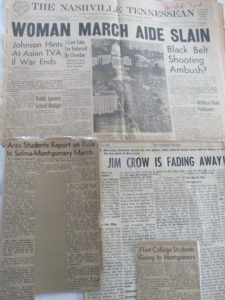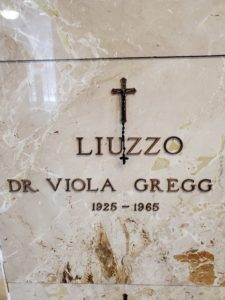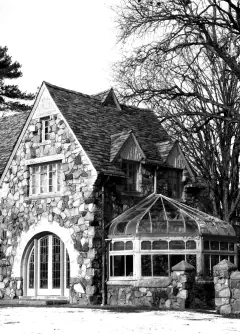By Harold C. Ford
Viola, Viola you laid your young life down,
From Selma to heaven, 3 Ks took you out,
Colorblind angel battled bigotry,
Viola, Viola lives on in history.
–“Color Blind Angel,” Robin Rodgers, 2008
[Author’s note: I was moved to write this personal reflection when my son Justin Ford gifted me a book: From Selma to Sorrow, The Life and Death of Viola Liuzzo, by Mary Stanton, University of Georgia Press, 1998. This review of the 1965 Selma-to-Montgomery march and the murder of Viola Liuzzo includes excerpts from Stanton’s book (in italics and quotes).]
Like Viola Liuzzo, I was piloting my car on the same ribbon of highway in Alabama, U.S. Route 80 that connected Selma and Montgomery, in the early evening hours of March 25, 1965 following the conclusion of the Selma to Montgomery march for voting rights.
Unlike Liuzzo who was murdered that evening, I would return to Michigan and live out the fullness of my life.

The personal mementos belonging to Harold Ford from Selma-Montgomery. (Photo by H.C. Ford)
Nine months earlier, my auto mechanic father had purchased and repaired the vehicle in which I and other Flint voting rights activists were being transported. It was a multi-colored ’56 Ford, a $100 high school graduation gift that would safely carry me and other student marchers the approximate 2,000 miles from Flint to about Montgomery, then back to Flint. And then that ’56 Ford died.
I was joined on that southern sojourn by eight other Flint college students. Victor Ruehle, 21, attended the University of Michigan-Flint. Karla Ribarchik, 19, was enrolled at St. Joseph Hospital School of Nursing. Connie Moss, 19; Rita Dibert, 19; Dale Shuert, 19; Roger Stephens, 21; and myself, then 18, were students at then-Flint Junior College (FJC). John Norton, 19, had studied at FJC and was planning to return. One other student was enrolled at Western Michigan University.
Like the Flint folk, Viola Liuzzo, 39, was also a college student — in her case at the University of Detroit where she studied nursing.
However, unlike the nine Flint folk, Liuzzo journeyed to Alabama alone, driving the family’s 1963 Oldsmobile two-door, the car in which she was killed.
The faith traditions of the Flint group included four Methodists, a Presbyterian, a Unitarian, a Free Methodist, and two Roman Catholics.
Liuzzo attended the First Unitarian Church of Detroit.
Every one of us were white and imbued with a goodly measure of youthful naivete about 1965 America.
“The grandest hour of the civil rights movement”
The idea for a civil rights march was initially inspired by the death of African American Jimmie Lee Jackson in Marion, a town near Selma, AL; he was shot dead attempting to protect his mother and grandfather from the attack of law enforcement officers. That scenario – a black citizen brutalized by law enforcers –is uncomfortably familiar to most 21st century Americans.
The ongoing brutal treatment of Selma’s black citizens who attempted to register to vote also fueled momentum for a march. They were largely denied the right to register.
The first attempt at a march was brutally turned back by Alabama state troopers and other law enforcers including white racists temporarily deputized by Jim Clark, the notorious sheriff of Dallas County in which Selma was located.
Fifty were injured; 16 were hospitalized. Lynda Blackmon Lowery, 14, needed seven stitches for a cut above her right eye and 28 stitches on the back of her head.
Peaceful men, women, and children; all they wanted was the right to vote.
Americans everywhere, of all stripes, committed to travel south deep into racist Dixie and join the Selma campaign following the beatdown of unarmed marchers and King’s clarion call to join a 54-mile Selma to Montgomery march for voting rights.
“In the March 19, 1965 issue of Life magazine, journalist Richard Stolley describing the voting rights marchers noted that ‘they came from everywhere – clergymen, nuns, students, doctors, plain Americans – Negro and white — to place themselves beside Martin Luther King in the streets, to stand against the police of Alabama in the name of human dignity. In all the turbulent history of civil rights, never had there been such a widespread reaction to the doctrine of white supremacy.”
“Thousands of people all over the country were making the same decision. Journalist George Leonard writing for The Nation (wrote) ‘hundreds of these people would drop whatever they were doing, that some of them would leave home without changing clothes, borrow money, overdraw their checking accounts; board planes, buses, trains, cars; travel thousands of miles with no luggage; get speeding tickets, hitch hike, hire horse drawn wagons; that these people mostly unknown to one another, would move for a single purpose: to place themselves alongside the Negroes they had watched on television.’”
Writer Stephen B. Oates deemed it “the grandest hour of the civil rights movement. Never in the history of the movement had so many people of all faiths and classes come to the southern battleground itself.”
Voting wrongs and voting rights
Reverend C.T. Vivian of the Southern Christian Leadership Conference (SCLC) described the Selma-Montgomery march as “a clear engagement between the forces of the movement and the forces which would destroy the movement … between those who wished the fullness of their personalities to be met and those that would destroy us physically and psychologically.”
The “forces that would destroy the movement” were revealed in this letter to the Selma Times-Journal written in March of 1965: “If the perverts from Washington, Boston, and other pink punks from the North would spend their time cleaning up the uncivil riots, murders, stabbings, prostitution, and mongrelization [read mixed-race relationships] in their own back yard and leave the Selma situation to the city of Selma under the able protection of local law enforcement, our Republic will remain free much longer.”
On the other hand, “the forces of the movement” were revealed in this statement by a black man in Selma speaking to the voting registrar: “I am 65-years-old. I own 100 acres of land that is paid for. I am a taxpayer, and I have 6 children. All of them is teachin’, workin’ … If what I done ain’t enough to be a registered voter … then Lord have mercy on America.”
Blacks made up approximately half the voting-age population of Dallas County, within which Selma was located, but only one percent of voting-age blacks were allowed to vote, in contrast to 65 percent of whites. Just 156 of Selma’s 15,000 blacks of voting age were on the voting rolls.
Antecedents
The historical antecedents of resistance to injustice, while traced backward to many, are surely found in the figures of Henry David Thoreau and Mohandas Gandhi.
Thoreau crystallized the concept of civil disobedience with an essay of the same title published in 1849. In 1843 he refused to pay a poll tax in Massachusetts because of his opposition to slavery; he was arrested and jailed. Thoreau also campaigned against payment of federal taxes during the Mexican-American War as he deemed it an effort to extend slavery into new territory.
Thoreau wrote: “Under a government which imprisons any unjustly, the true place for a just man is also in prison…”
Gandhi, a student of Thoreau’s tactics, expanded the notion of civil disobedience by adding masses of people; and Gandhi cultivated relations with the mass media to further his cause. Gandhi historian Geoffry Ashe notes that some journalists came to Gandhi “in a spirit of near-discipleship.”
Flash forward to 1950s and 1960s America and the movement led by Martin Luther King that included Gandhian nonviolent civil disobedience in its arsenal of tactics. King and his compatriots acknowledged their ideological predecessors as in this statement by Rev. James Bevel of the SCLC:
“The notion behind the Selma-to-Montgomery march ‘went back to some of the classical strategies of Gandhi … when you have a great violation of the people and there’s a great sense of injury … you have to give people an honorable means and context in which to express and eliminate that grief and speak decisively and succinctly back to the issue.’ “
“Land of the free, home of the brave”
The strategies and tactics of Gandhi, King, Bevel and others marched brusquely into my reality on March 7, 1965 as I was sitting on the sofa in the family living room watching television. The disgraceful images of Bloody Sunday bombarded before my senses.
Alabama law enforcers not only beat and chased peaceful marchers back across the Edmund Pettus Bridge, they also beat and chased from me long-held notions about America as an overidealized “land of the free, home of the brave.”
The Pledge of Allegiance was obscured by the ominous warning of Martin Niemoller in his homeland before Nazis took control: “In Germany they first came for the Communists and I didn’t speak up because I wasn’t a Communist. Then they came for the Jews … the trade unionists … the Catholics … and I didn’t speak up … Then they came for me and by that time no one was left to speak up.”
Black activist Eldridge Cleaver offered a more succinct version of Niemoller’s exemplar: “If you’re not part of the solution, you’re part of the problem.”
Route 80 and Interstate-65
Unlike Liuzzo, I and the eight other Flint-area compatriots turned our two automobiles off east-west Route 80 onto Interstate-65 headed northward back to Michigan. As she transported marchers back and forth between Montgomery and Selma along Route 80, Liuzzo was shot to death by a carload of Klansmen who included FBI informant Gary Rowe. Rowe became a very controversial figure in events that followed the march: Was he a participant? An informant? Or both?
About an hour later, driving in darkness near the Alabama-Tennessee border, we received the report of a sister Michigander’s death on the car’s radio. To say the least, we were all saddened by the news.
Though saddened, we were hardly surprised by the assassination. We knew the special animosity that southern whites reserved for out-of-state whites who rallied to the cause of black voting rights. We’d seen the “hate stare” reserved especially for race traitors like us. Federalized troops and civil rights demonstrators were akin to “foreign invaders.”
“In the 1960s, civil rights activists – especially white activists – were often considered troubled. Some whites, angered or frightened by the movement, believed that white activists were not seriously interested in the rights of blacks. But were instead immature rebels or neurotics who got involved in ‘the black movement’ to work out their own problems.”
“Gerald Frazier, a black reporter covering the march for the New York Daily News, reported, ‘This part of the White South has turned its wrath on Northern whites. ‘You niggers beat the crap out of them whites there with you and I’ll let you vote’ one cracker yelled to the (black) marchers.”
Attorney Matthew Hobson Murphy Jr. was the chief legal counsel for the men accused of killing Liuzzo. In open court, Murphy represented the views of many southerners, not all, when he called Liuzzo “a white nigger who turned her car over to a black nigger for the purpose of hauling niggers and communists back and forth.”
Some southern whites such as Clifford and Virginia Durr, dared to be civil rights and voting rights activists in their home state of Alabama.
Virginia Durr was asked by Stanton if she found the contributions of whites from other states helpful? Durr’s response was twofold:
- “Well, they gave us strength of numbers. They showed us we weren’t alone.”
- “People like Mrs. Liuzzo could help but she could always go home; we had to live with our decisions.”
But of course, Vi Liuzzo would never “go home.” She dutifully remained after the march to help escort marchers back to their homes in Selma. It proved to be a dreadfully fateful decision.
Coal miner’s daughter
Viola Fauver Gregg was raised in southern culture. She was born April 11, 1925, in California, PA, a mining town on the Monongahela River less than fifty miles from the West Virginia border. Her father was a coal miner.
After two previous marriages, she found herself in the Detroit area married to a union official, Jim Liuzzo. She birthed five children. She was a restless soul.
“Vi was looking for something she couldn’t fully articulate … She enthusiastically shared that search with her family – reading the essays of Thoreau and the dialogues of Plato to her children, discussing her ideas and new discoveries and listening to music with them, taking them on field trips, and celebrating every holiday and every birthday with a party.”
“Jim Liuzzo was convinced that his wife had made up her mind to go to Selma on March 7, 1965, during the eleven o’clock news, as she watched the Alabama state troopers beat voting rights demonstrators on the Edmund Pettus Bridge.”
Viola Liuzzo decided to drive south, alone. Jim prophetically warned his wife, “… to be. careful, that the most dangerous time would probably be after the demonstration when the troops wouldn’t be around to protect the marchers anymore.”
It was likely the last advice Jim ever gave to Viola.
“Third most segregated city in the nation”
The two carloads of college students from Flint returned home to the relative safety of our community and its own brand of racial apartheid, northern style, that was rarely acknowledged then by those of us who grew up in it.
The scholarly work of author Andrew Highsmith – Demolition Means Progress, The University of Chicago Press, 2015 – would document a most unflattering story of Flint’s racial history:
“By the close of the 1930s, the widespread use of restrictive covenants by local residents had helped make Flint the third most segregated city in the nation, surpassed only by Miami, Florida, and Norfolk, Virginia.”
“Third most segregated city in the nation” for God’s sake! Not Jackson, Mississippi. Not any city in Alabama. Flint. Flint, Michigan. Those of us who marched for rights in Alabama should have more fully recognized the unfinished racial justice work in our hometown.
Requiem
Some 58 years later, the Selma-Montgomery experience remains the most fearful of my lifetime. Yet, I realized almost immediately as we made our way back to Michigan, we’d left behind communities of color that would negotiate and endure the fear ingrained in the so-called “Southern way of life” the rest of their lives.
The deaths of Jackson, Liuzzo, and James Reeb, a Unitarian minister from Boston, during the Selma campaign would help move President Lyndon Johnson, a southerner, to utter the well-known words of King — “We shall overcome.” – in an address to the nation in which he called for passage of a voting rights act.
The Voting Rights Act (VRA) of 1965 became law. “The Act changed the course of southern politics. Following the arrival of a federal examiner in Selma, the percentage of voting age blacks registered rose from less than 10 percent to more than 60 percent in just two months. By 1966 more than nine thousand blacks were registered in Dallas County.”
Overall, black voter registration in the U.S. soon went up by 61 percent to more than five million voters. In 1965 there were only 100 black elected officials in the continental U.S. By 1989, 24 years after VRA’s passage, there were more that 7,200 black officeholders in the nation. In 2008 and 2012, the nation elected and reelected Barack Obama, its first African American president.
In recent years, a conservative U.S. Supreme Court has repeatedly gutted the VRA. President Joe Biden walked the Edmund Pettus Bridge last month on the anniversary of Bloody Sunday and vowed to restore VRA provisions. “This fundamental right remains under assault,” he said.
No one was ever convicted of Liuzzo’s murder. A roadside marker in Lowndes County, AL, installed in 1991, commemorates her sacrifice. She was the only white woman murdered in the modern civil rights movement.

Viola Liuzzo’s final resting place at the Holy Sepulcher Cemetery, Southfield, MI. (Photo by H.C. Ford)
Many responded to her death unsympathetically in all sections of the country. A cross was burned at her Detroit home; the two Liuzzo boys were called “nigger lovers” at school; six-year-old Sally had rocks thrown at her; garbage was strewn on the Liuzzo’s lawn. Jim Liuzzo hired an armed guard to protect the family from threats.
As Stanton writes, “Vi Liuzzo’s tragedy was that white society, even in death, wished she would just go away.”
Liuzzo’s remains are interred in the huge mausoleum at the Holy Sepulcher Cemetery in Southfield, MI. Her final resting place is sparingly identified in capital letters on the marble-fronted sarcophagus: “LIUZZO, DR. VIOLA GREGG, 1926-1965.” A more complete epitaph might include two lines from the second verse of singer-songwriter Robin Rodgers’ 2008 musical tribute:
Motor City mother, lily-white and sincere,
Gave her life for the civil rights, fought against the fear.
EVM writer and education beat reporter Harold C. Ford can be reached at hcford1185@gmail.com.


You must be logged in to post a comment.